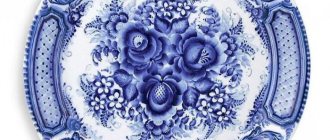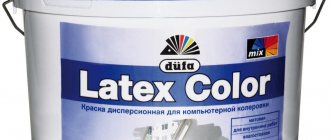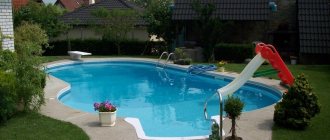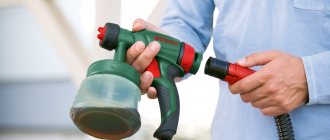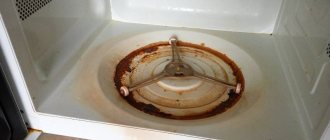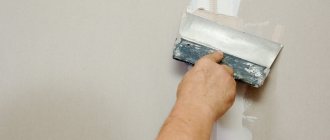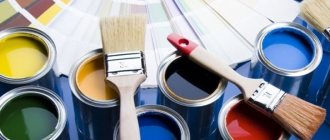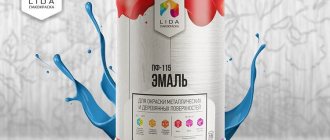Rubber pool paint: pros and cons
Advantages of acrylic material
Rubber paint for swimming pools has a number of advantages that are not available to most paints and varnishes, namely:
- Increased waterproofing layer;
- Elasticity;
- Resistance to temperature changes;
- Resistance to mechanical deformation;
- High degree of adhesion;
- No peeling;
- Easy to apply using a spray gun or by hand;
- Profitable price;
- Versatility of use;
- Waterproof;
- No smell;
- Fire and explosion safety;
- Durability.
Rubber paint is characterized by increased resistance to the negative effects of the external environment, including sea water.
The presented type of paint and varnish products, when applied in two or more layers, has a striking difference from all previously invented products. In terms of tactile sensations, rubber paint literally resembles rubber, pleasant and soft. It can be used to cover any surface, as a result of which it will become matte-smooth, while removing the smallest nicks and cracks.
Rubber paint represents an innovation in water-based acrylic paints. According to environmental studies, the ingredients included in its composition do not pose any harm to the environment and human health throughout the entire period of operation, since no harmful substances are released.
Disadvantages of waterproofing
The only disadvantages include the prohibition of using it for painting furniture, floors or doors. You also need to be extremely careful with solvents that negatively affect rubber paint.
Possessing a wide range of color shades, rubber paint allows novice craftsmen and professional designers to play to their hearts’ content with the most original and daring solutions. The most commonly used color is blue for pool water.
How and with what to paint a concrete pool?
The popularity of concrete artificial swimming ponds is extremely high, because they are strong, durable, easy to maintain and easily repaired, environmentally friendly and decorative. But after their construction, the question immediately arises: how to paint a concrete pool inside the bowl? And this is where the difficulties begin. It is necessary to find a paint and varnish material that will withstand constant exposure to water and chemicals and will adhere perfectly to the concrete surface. In addition, the environmental characteristics of the material are also important, as well as its resistance to ultraviolet rays and decorative properties. The choice is extremely difficult, especially considering the wide variety of materials and manufacturers. We carry out interior finishing of swimming pools using various materials. If necessary, you can order high-quality and safe pool paint from us.
How to properly paint a concrete pool?
Having chosen the paint by color and quality, you can get to work:
- drain the water in the pool - remove any remaining debris, dirt, silt and plaque;
- remove old paint - you can use a brush with metal bristles;
- remove dust and debris, rinse the bowl with a 50% acidic solution, rinse with water;
- treat surfaces with 3-sodium phosphate solution, rinse with water;
- degrease surfaces;
- assess the condition of surfaces - fill cracks and defects;
- prime (if indicated in the instructions for the paintwork);
- wait until the surfaces dry;
- apply paint.
Waterproof pool paint - long-lasting protection
There used to be a belief that paint would not withstand constant exposure to water, but modern chemists have refuted this by creating a wonderful paint for swimming pools. This coating is particularly resistant to impact and abrasion, and it is absolutely impermeable to water.
When it comes to finishing the pool, many are inclined to paint it, because this type of finishing will cost much less than tiles or mosaics and will last a fairly long period.
Why do most builders choose concrete paint for their pool?
The most popular type of pool has become a reinforced concrete pool. Firstly, because concrete is a fairly strong and durable material, and secondly, a reinforced concrete pool can be of any shape and depth. A special paint for concrete pools was developed, which has already shown itself only on the good side.
One of the most used types of paint is acrylic pool paint. This paint is characterized by high water resistance, elasticity and mechanical strength. It is used for decorative and protective painting of the underwater and above-water parts of the pool. The waterproof paint proved to be excellent in use. Acrylic paint for swimming pools, reviews of which are only positive, of course, if you buy high-quality paint from a specialized color studio.
Also quite often, rubber pool paint is used to paint swimming tanks. Rubber paint is used for swimming pools because it covers the concrete walls of the pool with a breathable, waterproof film. Rubber paint for a concrete pool shows excellent performance. You can apply this paint directly onto concrete, and if necessary, you can use it to cover tiles that have lost their appearance.
What properties should pool paint have?
Of course, first of all, when thinking about how to paint a pool, you must understand what to expect from good paint. Pool paint should be a good sealant and waterproof. It should be resistant to both frost and heat, and the scorching rays of the sun should not change its color.
Since people swim in the pool, the paint should not cause allergies. As a rule, to prevent water from becoming contaminated, various chemicals are added to the water, which are not harmful to humans, but are deadly to bacteria; therefore, the paint should not be destroyed under the influence of bleach and alkaline solutions. Also, the paint itself should protect the surface of the pool from fungus and mold. Only two-component epoxy paints for concrete and metal pools meet such high requirements.
Where can I buy this material and what does its cost depend on?
We strongly recommend purchasing pool paint from specialty stores or color studios. Our color studios observe special conditions for storing paint and varnish products, under which all paints retain their properties.
The feasibility of installing waterproofing in a swimming pool
By insulating against leaks in the construction of swimming pools we mean a set of works to provide effective protection against water and moisture. The bowl of this structure is a complex structure that holds large volumes of liquid. The aquatic environment exerts great pressure on the walls of the structure, which increases when the tank is filled or drained.
The slightest defect in the form of a crack under the influence of moisture can become a serious threat to the integrity of the entire structure. Therefore, it is important to prevent in advance the possibility of water contacting the load-bearing walls of the structure.
Stationary pools are usually built from concrete. This material has a porous structure, due to which moisture is absorbed instantly and quickly destroys the concrete base.
However, contact with moisture negatively affects not only concrete, but also the metal rods that reinforce the walls of the tank from the inside. Water passes freely through the porous concrete to the reinforcement. As a result, the metal is subjected to corrosive processes and quickly deteriorates.
Thus, without a high-quality moisture-proof coating for a pool, subject to serious loads, the bowl will simply crumble in the literal sense of the word.
High-quality waterproofing of the pool bowl must meet the following requirements:
- strength and reliability;
- long service life;
- high resistance to adverse external influences;
- good adhesion;
- high elasticity.
Ideally, if the insulating layer, in addition to all the listed properties, forms a seamless monolithic surface covering the entire plane of the structure.
Concrete pool painting technology
- Purchase chlorinated rubber paint from a hardware store.
- Remove water, various debris and pollution from the reservoir.
- Clean the concrete surface with a wire brush and scraper to remove old paint, remove all dust, wash the entire surface of the pool with a 50% acid solution, and rinse with clean water.
- To neutralize the acidic composition, treat the pool with 3-sodium phosphate solution, degrease the surface, and rinse again with clean water.
- Fill all defects (cracks, holes) with cement mortar.
- Be sure to let the entire surface dry.
- Apply elastomer-based paint with a wide roller, starting from the deepest place, moving up to the top, using a brush to paint hard-to-reach places (valves, lamps, drainage).
- Paint with rubber must dry for the period of time specified in the manufacturer's instructions, as this is necessary for reliable and durable fixation (approximately 3-5 days).
- Fill your new pool with water and change the filtration settings for service.
Additional recommendations:
- Be sure to thoroughly mix the coloring composition before use;
- do not carry out work when it is very hot, cold or high humidity (the surface may stick together);
- apply the composition in the thinnest layer so that bubbles do not appear;
- When working with acidic cleaning mixtures, be sure to wear safety glasses and gloves.
Pool paint containing elastomers is the optimal and ideal choice. You no longer need to redo your pond every few years, because this material is durable and reliable. And there is no need to worry about your pool leaking water.
Painting a concrete pool with liquid blue paint
It is advisable to carry out preparatory work in stages:
- Sand;
- Putty, then sand;
- Treat with primer;
- Degrease the surface;
- Sand all glossy surfaces, if any, to a matte finish;
- Rinse the area with water and dry.
If desired, in order to improve the protective properties and reduce paint consumption, after thorough processing, auxiliary layers of putty, primers, and antiseptic compounds can be applied.
Before directly applying liquid rubber, it is important to adhere to the following rules:
Mix the paint thoroughly before use; If necessary, dilute the paint with water, although this is often not required; Apply to a dry surface with a brush or roller in a couple of layers.
If you work with a sprayer, make sure that the temperature does not drop below five degrees. When working, stir the paint product regularly; Apply the next layer exclusively to the dried surface of the previous one; At the end of the work, do not forget to rinse the tools thoroughly. This material will tell you what a rubber coating for playgrounds in the country is.
This material will tell you what rubber coating is for children's playgrounds in the country.
After painting, try to maintain the coating regularly. It is not particularly difficult, but will allow the rubber paint to serve you for a long time. To do this, it is enough to periodically monitor the surface and, if necessary, carry out restoration of the pool:
- Remove rust;
- Apply sealant;
- Carry out coloring.
Washing with soapy water and treating with an antiseptic is allowed.
All-weather rubber paint-sealant Polymeral
Paint-sealant Polymeral is an innovative new generation product for professional use. The one-component organic solvent composition is based on a complex of polymers from BASF Corporation and special copolymers and catalytic additives of its own design.
The selected composition of polymers and solvents allows the application of Polymeral paint-sealant to any surface without prior application of a primer.
The main purpose of the paint-primer Polymeral is a protective universal coating both on metal surfaces (has high anti-corrosion resistance of the coated metal) and on concrete and wooden bases.
Recommended as a universal weather-resistant protective coating for bridges, tunnels, overpasses and similar engineering structures. It is convenient to paint both metal and concrete elements with only one type of paint. Covering for sports fields and gyms: injury-proof due to the springy effect of the rubber coating, wear-resistant, easy to clean, does not fade: 100% resistance to ultraviolet radiation. It is an excellent waterproofing sealant. Recommended for painting hydraulic structures: swimming pools, ponds, piers, sewers, etc. Ideal for painting wooden boats and boats (for painting metal boats, you need to use rubber primer paint Polymeral Metal Anticorrosive).
All-weather application. Frost resistance (-55 C). Increased elasticity does not lead to damage to the coating at the metal-concrete transition and similar ones with greatly varying coefficients of thermal expansion.
The resulting coating is acid-alkali resistant. Insensitive to salt solutions and suspensions (resistant to sea water). Significant resistance to constant and massive exposure to petroleum products and oils. The coating is resistant to ultraviolet radiation and ozone. Does not turn yellow over time.
The short curing time allows the second (finishing) layer to be applied in half an hour depending on the ambient temperature.
Consumption for two-layer application, grams/sq. meter: 500
Guaranteed shelf life: 12 months.
The service life of the coating is at least 10 years.
Can be applied at temperatures down to minus 25C!!!
Color Chart
Article Family of Polymers
Article Painting a pool, fountain, pond
All-weather rubber paint-sealant Polymeral instructions
Photo illustrations of methods of application (more photos in Yandex Collection)
Pool painting
The last part of the finishing is the embodiment of all your design thoughts. After all, not only the operational characteristics of the finishing of the concrete pool bowl, but also its appearance, beauty, and harmonious combination with the entire recreation area and the site as a whole depend on the external finishing. Also, your pool should fit well into the composition of the house, fence and surrounding vegetation.
The choice of finishing materials is huge:
- Polymer materials.
- Composite materials.
- Tiles and mosaics.
- Hydrofilm.
- Painting.
Advantages of coloring:
- ease of application,
- huge selection of paint textures,
- wide variety of colors,
- good sealing of the pool,
- water resistance,
- environmental friendliness.
Among the shortcomings, I would like to highlight one: the surface of the walls and bottom are uneven and very lumpy, then over time the paint may come off in places of great unevenness. One way or another, the paint layer will need to be renewed every year.
To do this, before applying paint you should:
- Using a trowel, remove any cracked or swollen parts of the plaster.
- Re-plaster these areas.
- Seal with sealants
- Apply paint to a flat surface.
Even a child can paint the surface of the pool - no additional skills are required. Considering that the paint is the same as a sealant for the pool bowl, it is necessary to paint it carefully and it is advisable to apply 2-3 layers.
Selection rules
In order for painting with liquid rubber to bring the desired result, you must follow some selection rules:
- Check with the store for details. If you need paint for wood, then one that is designed for metal will not work. Although, there is a universal type. The fact is that specialized paints contain certain components. For example, anti-corrosion substances are added to the mixture for metal, antiseptic substances for wood, and components that protect against ultraviolet radiation and frost for roofing.
- Choose products based on the climatic conditions of use. European paints are not designed for the severe frosts of Siberia, so preference should be given to the Russian manufacturer.
- Be sure to check the expiration date and release date. Expired products will not lie perfectly on the surface.
- Ask the seller for documents certifying the authenticity of the paint - a certificate.
Rules and procedure for painting
The durability of the coating depends on proper preparation of the surface before painting:
- cleaning from dust and dirt;
- cementation of chips and cracks;
- sanding a smooth surface;
- padding.
The surface of the iron pool is cleaned of rust and impregnated with an anti-corrosion primer. The concrete surface is washed with a 50% acid solution, rinsed with clean water and neutralized with a 3-sodium phosphate solution. Then the walls are degreased and washed again with water.
How to properly paint a pool with rubber paint:
- apply to a dry surface alternately in thin layers from bottom to surface;
- the previous layer must dry completely, usually within two hours;
- to work outside, choose a sunny, windless day;
- paint at positive temperatures;
- Stir the mixture periodically.
It is not recommended to apply paint in one thick layer. The coating will dry on the surface, but will remain wet inside, so its strength will be significantly reduced.
The pool bowl can be cleaned with detergents 8 days after painting. If the painting technology is done correctly, the coating will last 10 years or more.
Stages of preparation for painting
Before you begin choosing a coating, you need to prepare the pool bowl for applying the finishing coat. Preparation consists of several stages:
- Prepare the surface: it should be dry. Concrete gains strength within 28 days, and this period must be met;
- if we have a new bowl, we remove the construction dust, if it is old, we remove the previous layer of paint and also remove the dust;
- We prime the bowl using special solutions. Pool primer creates a monolithic thin layer with concrete and provides better paint coverage;
- direct coloring.
Features of the floor on the verandas
Floor treatment on outdoor terraces differs from that inside the house. This is due to the fact that it is affected by many unfavorable environmental factors. Among them, the greatest impact is exerted by:
- temperature changes over a day and a year, due to which the boards either decrease in size or increase in size, and ice can form inside them, which leads to the destruction of the material;
- precipitation in the form of rain and snow, as well as morning dew penetrate the pores of the wood, causing rot and destruction of the floor structure;
- sunlight spoils the colored floor covering if it is chosen incorrectly, as a result of which the appearance of the veranda becomes faded and sloppy;
- mold and other types of fungi easily settle on street surfaces, because nothing prevents the spread of spores;
- adult insects and their larvae eat wood, forming passages and holes in it, and rodents make holes, which can cause destruction of the structure.
You need to select paint for the terrace floor taking into account all the factors affecting the coating and operating conditions. To ensure that your summer house always looks well-groomed, you need to choose the right materials and go through all stages of processing. This will help protect the wooden floor from destruction and fading.
Plastering and waterproofing
Finishing a concrete pool begins with plastering. Its goal is to give the walls and bottom of the pool as smooth a surface as possible. After all, on a lumpy base it is difficult to strengthen any building materials during finishing and the paint will adhere poorly, and over time it will swell and burst. 1-2 small irregularities per 4 square meters are allowed. It is advisable that the unevenness be no more than 1 mm, otherwise the finishing materials will not lie tightly on the plastered surface, and this can lead to the finishing coming away from the surface of the pool literally after the first season of operation. Cracks or crevices are completely excluded, since the vessel for filling with water must be as tight as possible and not subject to pressure from large amounts of water. Finishing concrete pools involves 2 main types of hydroresistant plaster:
- plastering on the mesh;
- using glue.
The first plastering method:
- We attach the mesh to the surface of the bowl with dowels. The quality of the mesh should be as anti-corrosion and waterproof as possible. Therefore, experts recommend glass or synthetic mesh (they have a high price, but guarantee the durability of the structure).
- We provide maximum adhesion to surfaces, making the concrete surface rougher.
- We use waterproof plaster mixtures.
- Apply plaster to the mesh and level the surface.
- Let the material harden (it is better to lay a cover on the pool to prevent damage).
When applying adhesive plaster, we use special impregnations, having first thoroughly cleaned the walls of dirt and any debris. After applying a special impregnation made from acrylic resins, urethane and other polymers, we apply a layer of the most special plaster, which contains an adhesive polymer.
Painting a pool with rubber paint provides additional sealing to the pool bowl and at the same time makes it suitable for use. Many people save on further finishing of the pool and limit themselves to painting it from the inside.
Internal waterproofing
The pool bowl is a monolithic reinforced concrete structure, and the penetration of moisture into the micropores of concrete will inevitably lead to corrosion of the reinforcement frame and a decrease in the strength of the entire bowl. Moisture trapped in micropores under the influence of negative temperatures will begin to expand and form cracks. The mass of water in the pool bowl constantly exerts static and periodically dynamic pressure on the structure, accelerating negative processes in the material of the bowl. Internal waterproofing should resist this.
To install internal waterproofing, the concrete bowl is cleaned of dust and debris, checked for cracks and seams, which are treated with materials to seal the seams. Sealing tapes are used to seal joints.
The surface of the bowl is leveled by plastering the walls with waterproof compounds for swimming pools; a self-leveling mixture is used to level the bottom. All surfaces are primed with a primer (Gruntofol, AquaDur).
Next, the type of waterproofing is selected based on the customer’s capabilities:
- For lining, materials based on polymerized bitumen are used (Stekloizol, Stekloelast, Rubitex). They are laid hot.
- For coating, mastics such as Cemizol 2EP, Idrosilex Pronto, Ceresit, and Penetron are used. In terms of their composition, these are polymer-cement mastics that create an elastic layer on the surface of the bowl.
- Waterproofing a pool can be done with bitumen-polymer mastic, which is called liquid rubber. Liquid rubber is sprayed with a compressor (for large volumes of work) or applied using a roller or brush. This mastic has increased adhesion to the surface of the pool bowl and creates a durable, elastic layer with excellent waterproofing properties. Liquid rubber combines the qualities of liquid waterproofing and PVC membranes. You can lay mosaics or tiles on the resulting layer. Manufacturers have now mastered the production of liquid rubber in different colors, which eliminates the need to lay down a finishing layer and eliminates the need for decoration. Liquid rubber is as pleasant to the touch as membrane materials. If the work on applying this bitumen-polymer mastic is carried out by a team of specialists (usually 3 people), then they can process up to 1000 m² per shift.
- The use of membranes allows you to combine waterproofing and decorative functions. Membranes are produced that imitate marble, mosaic and other finishing materials. The disadvantages of this material include the rather high cost and complexity of the application process. First, the corners and contact lines of the bowl surfaces are treated with a special liquid, then reinforcing fabric is glued to these places, and the liquid is applied again. After drying, the liquid is applied with a roller to the entire internal area of the pool. A reinforced fabric is laid over the liquid, carefully distributed over the bottom and walls, and again covered with a special liquid. After drying, all layers form a single continuous membrane with excellent waterproofing properties. Membranes require strict adherence to installation technology and control over the safety of the material.
- The most affordable material for pool waterproofing is PVC film. Typically, such films are used on inexpensive pools. After the film is spread, the seams are welded with a construction hairdryer. The laying speed of this material is high. The disadvantages include a very small selection of material shades and the inability to spread the film without seams, which will be clearly visible in the pool.
When installing waterproofing, sealing cords must be used to seal joints and seams, for example, Penebar polymer cord. The polymer swells upon contact with water and seals the gap or seam. After sealing the seams with cords, they are treated with a penetrating waterproofing compound.
After waterproofing work is completed, mosaics or tiles are laid on the walls and bottom. To prevent water getting through the tile joints from causing the tiles to peel off, special insulating grouts are used. Insulating grouts are polymer or epoxy compounds. Using a rubber spatula, they are pressed into the space between the tiles. Immediately after application, the tiles must be wiped so that the remaining composition does not dry on the surface.
Before starting work on waterproofing a swimming pool, it is recommended to evaluate your capabilities and strengths. There is a very important stage to be completed, and failure to comply with the technology, carelessness, and inattention can be very expensive in the future. Choose the type of waterproofing that you can handle yourself, while doing all the work efficiently.
What outdoor pools can be painted with it?
Often the bowls of outdoor pools are made of concrete. Before tiling the pool, a reinforced mesh is placed on the bowl, after which the tiles are laid. Rubber paint can be applied to both tiles and concrete bases to give a finished and aesthetic look to the new object. Using dark paint will significantly save the cost of heating the pool.
Find out about the types of in-ground pools for your summer cottage at this link.
Another option for installing a summer outdoor pool is to purchase an inflatable rubber one. The feasibility of painting such a pool does not raise any questions, since the rubber coating layer can protect the inflatable surface, as a result of which the pool will serve for many years.
How to choose the right composition
When choosing rubber paint, you need to consider the type of tank. Most often, pools are metal or concrete, as well as reinforced concrete.
For concrete pool
Best options:
- hydrostone;
- chlorinated rubber;
- acrylic.
PVC is superior to other compounds in economy and durability. If the walls of the pool are not perfectly smooth, it is better to abandon the polyurethane coating.
For metal pool
The walls of iron tanks are characterized by poor absorption
Therefore, when choosing a coating, you need to pay attention to its adhesive properties. Epoxy paint adheres best to metal
Which finish to choose for a concrete pool
At the final stage of the construction of artificial reservoirs, the question arises: “What is the best way to finish a pool?” The choice of material determines the external aesthetics, service life of the tank, its performance, as well as the possibility of installing additional equipment in the bowl.
Conclusion
When constructing concrete pools on a turn-key basis, specialists most often use PVC film and mosaics to line the bowl. The choice of material is influenced by 3 factors:
- how much time is allocated for cladding;
- pool bowl design;
- budget.
If you cannot decide on your own how to finish a concrete pool, contact our managers, they will help you choose the best option.
Manufacturers
The coloring rubber substance is produced in different countries. To compare their properties and costs, you can refer to the table:
| Paint name | Plasti Dip | Rezolux Universal | Rubber Paint | Fabrex |
| Manufacturer (country) | USA | Russia | China | Ukraine |
| Purpose | Ceramics, cars, glass, wood | Versatility of use - metal, wood, concrete surface, paving slabs, cars, plastic, etc. | Car, metal | Wood, metal, slate, roof |
| Assortment of shades | Wide range | 8 basic tones | Wide range | 9 primary colors + 5 additional |
| Coverage type | Glossy surface, matte and fluorescent | Smooth and textured surface | Matte | Matte |
| Approximate consumption | 150 ml per 1 sq. m. | From 100 ml to 200 ml per 1 sq. m. | From 130 mm to 150 mm per 1 sq. m. | From 100 ml to 200 ml per 1 sq. m. |
| Drying time for each layer in minutes | 60 minutes | 30 minutes | 30 minutes | 120 minutes |
| Shelf life | 10 months | 1 year | 1 year | One and half year |
| Packaging | Cans of 0, 310 l, 3 kg 78 grams, 5 liters. | Cans of 7, 14, 18 kg. | 400 ml can. | Banks of 1.2; 3.5; 6; 12 kg. |
| Price in euros | 310 ml – 15 euros | 14 kg – 17 euros | 400 ml – 10 euros maximum | 1.2 kg – 3 euros |
How to calculate the amount of material?
Each manufacturer writes the usage rate on the packaging at the rate of grams per square meter. This data must be applied to your own pool and multiplied by the number of layers. You can use the calculator on the seller’s website or calculate everything manually.
First you need to calculate the area of each tank wall and bottom and add these numbers:
- S1 (bottom)=length*width;
- S2 (walls)=height*width;
- S3 (walls)=height*length;
- S (pool)=S1+S2*2+S3*2.
The area of each alcove or recess, if any, is calculated separately. After this, the consumption indicated by the manufacturer is multiplied by the number of square meters. It is recommended to add 5-10% to the final volume.
For a pool with a square bowl, it is easier to calculate the amount of paint, because the walls will have the same area :
- S1=4*4=16 sq.m.;
- S2, S3=4*1.5=6 sq.m.;
- S=6*4+16=40 sq.m.
For example, let’s take paint with a consumption of 180 g per 1 sq.m. 180*40=7 kg 200 g. This is how much paint will be needed to apply one layer. If painting will be done in 2 or 3 (for an old surface) layers, the amount of paint must be multiplied by this number.
Example for a rectangular pool:
- S1=8*4=32 sq.m.;
- S2=1.5*4=6 sq.m.;
- S3=1.5*8=12 sq.m.;
- S=32+6*2+12*2=68 sq.m.
Let's take 120 g/1 sq.m. of paint per painting. 120*68=8 kg 160 g per layer.
Characteristics
Having built a pool bowl (concrete or metal) and carried out good waterproofing, the next step is to treat the surface by applying rubber paint. Before purchasing a product of a particular brand, you need to familiarize yourself with all its features and composition.
Rubber paint is the newest type of water-based acrylic paint and varnish composition. It is environmentally friendly, harmless to health, breathable, with a soft flexible texture, suitable for any outdoor and indoor use. All components included in this mixture do not pose any harm to nature, since they do not emit hazardous substances either during application or use.
This waterproof substance creates a very dense coating, soft and pleasant to the touch, and reliably protects the surface of the tank. The product contains:
- water (used for dissolution, does not exceed 5% of the total mass);
- acrylic latex (necessary for high stability and flexibility);
- coalescent (component used to form a film);
- antifreeze (will protect the finished coating from exposure to sub-zero temperatures);
- preservative (affects the life of the paint);
- additives, pigments, fillers (to improve the properties and give color to the finished product).
Characteristics and properties of the composition
- excellent adhesive quality (adhesion) and waterproofing, perfectly covers areas of various sizes and materials used in the production of pools (concrete, metal);
- resistant to temperature changes (not afraid of severe frosts and high heat) and atmospheric influences, to any mechanical stress and ultraviolet radiation;
- the composition with rubber hardens very quickly, within one to two hours;
- easy to use, you only need to have a brush or roller; spray paint cans have become popular lately;
- the surface is not slippery at all, reduced risk of injury;
- long service life (8-10 years);
- Rubber pool paint does not contain hazardous substances, is completely safe, does not cause allergic reactions, and provides protection against fungi and mold;
- When dried, it acquires the properties of flexibility and extensibility, and has a pleasant and velvety texture.
In the production of rubber-based paint, manufacturers use the following components: five percent water (solvent), acrylate rubber, which imparts strength and elasticity, a plasticizer for film formation (coalescent), antifreeze liquid (frost-resistant property), preservatives (for storing the composition, does not provide growth of fungus and mold), various additives (fillers, coloring pigments).
Painted pool ready to be filled with water
Tips for choosing
When choosing paint for an outdoor pool, you need to be completely confident in its quality and that it is suitable for the material from which the tank is made. Be sure to look at the expiration date, since spoiled dyes may begin to bubble, peel off, and they will not last half the promised period. In addition, it would not be a bad idea to ask for a quality certificate.
If we are talking about concrete pools, then hydrostone is the best choice. This paint will require little, it is applied in 1-2 layers and dries quickly. Chlorinated rubber and acrylic are also good options; polyurethane paint takes the longest to dry. For metal and other types of pools, experts recommend epoxy and acrylic solutions.
Manufacturers
There are not so many manufacturers of truly high-quality pool paints. Let's consider several brands.
- Stancolac. This is a Greek company specializing in the production of paints and varnishes. It produces paints for all occasions: for home, ships, swimming pools, asphalt, wood and concrete, metals. Any pool paint will please you with its quality; in addition, they are all anti-corrosion. You can also purchase a primer in the kit.
- Isaval. A Spanish manufacturer that has earned many positive reviews. The range includes paints for building facades, interiors, floors, as well as primers and preparatory materials. Pool paints are incredibly resistant to chemicals, corrosion, and alkalis. Prevents fungal formations and is safe for health.
- Tutgum Dengal. This is paint from an Israeli manufacturer. Suitable for concrete pools, characterized by increased resistance to temperature changes and chlorine. Available in 2 colors: blue and blue. Can only be used for freshwater tanks.
- "Citadel". This paint is produced by. This is a rubber paint that has received good reviews from customers. “Citadel” is quite durable; it will resist mold, wear, and the appearance of lime for many years. Suitable for metal and concrete, tolerates salt water well.
Advantages of paints and varnishes
When thinking about how to paint the inside of the pool, you initially decide not on the price and color of the material, but on its qualities. Paint that is suitable for operating conditions and applied correctly will last at least 12-15 years. We purchase paint and varnish materials from proven and reliable manufacturers. Their products have:
- improved hydrophobicity;
- elasticity and plasticity;
- resistance to temperature changes and mechanical loads;
- excellent adhesion to the concrete base - does not peel off, does not warp;
- ease of application and ease of use - no special skills required;
- waterproof, safety;
- affordable price.
The paintwork material must protect the walls and bottom of the pool from the formation of plaque and sedimentation. The hardened layer should not be loose and soft, it should form a tight and elastic film that is resistant to aggressive loads.
If you're not sure what paint is right for the pool in your home or yard, check out the basic characteristics of the most commonly used materials.
More than 2000 objects have already been sold!
Types of pool paint
Pool paint has main varieties:
- Acrylic;
- Chlorinated rubber;
- Rubber;
- Liquid plastic;
- Two-component epoxy.
The paint of a concrete pool must meet the following criteria:
- Good application to the surface - with impregnating properties.
- Resistance to temperature changes, frost resistance.
- Vapor permeability through a paint layer.
- Durability.
- Minimal exposure to external mechanical influences.
- Anti-slip surface.
- Quick and easy to apply.
- Fast drying.
- Safety in use.
- Environmentally friendly.
| VD-AK-425 | 100 rub./kg |
| Ecoroom | 1193 rub. (14 kg) |
| SuperDecor | 720 rub./l |
| VDAK 103 | 104 RUR/kg |
| F310 Optimist | 1200 rub. (14 kg.) |
| AKVA CCCP | 215 RUR/kg |
| Hydrostone | 289 RUR/kg |
When choosing what paint to paint the walls of the pool, you can remove the anti-slip surface from the above points. After all, this criterion is more suitable for painting the bottom of the pool. And the walls can be smooth, so two-component epoxy paint is suitable, which is distinguished by its varnished glossy surface when dry. Acrylic pool paint will also give the impression of a smooth, shiny surface and resemble PVC film or tiles.
These types of paints are inexpensive and are often used by summer residents to paint facades and street buildings. But still, the most durable and high-quality, but also more expensive, are chlorinated rubber paint for pools and rubber.
These paints additionally have the following properties:
- Easy to apply to any materials;
- Huge selection of paint textures;
- Good sealing of the pool;
- Increased water resistance.
Such paints can be applied in one layer, unlike others - in 2-3 layers. All types of pool paints can be applied easily using:
- Brush;
- Valikov;
- Spray bottle.
Where and approximately at what cost is it sold?
Today, paint and varnish materials for treating artificial reservoirs can be purchased in construction stores from various manufacturers. The price depends on the brand, container volume and quality.
After analyzing the range of online stores, we compiled a table of the most popular manufacturers :
| Manufacturer | Price |
| Tikkurila Reaflex 50 | 920 rub/l |
| Adhesive | 350 rub/kg |
| PromColor | 250 rub/kg |
| Hydrostone RAL | 4100 rub/piece (10 kg) |
| Citadel | 390 rub/kg |
| Absolute | 310 rub/kg |
| Rufa | 100 rub/kg |
Rubber paint is economical to use. When painting a concrete tank in 2 or more layers, adhere to a ratio of 400 g/m².
What paint to paint the walls in the pool
Rubber paint for pools (also called enamel) is an old reliable friend when building any concrete structures, in this case a concrete pool. Like chlorinated rubber paint, it is suitable for metal pools, as it has good adhesion to any surface - even super-smooth ones like a metal plate. When dry, this paint resembles velvet - with a fleecy, non-slip surface. It is stretchable and flexible, which allows it to fill even the most microscopic pores of the concrete surface when applied. This paint is absolutely not susceptible to fungi, bacteria, spores, and harmful microorganisms.
Often, builders of country pools use a combination of colors for the inside of the pool. This helps to avoid unnecessary traumatic situations when relaxing in the pool. If you have a good budget for the construction of a swimming pool, rubber paint is applied everywhere, even in the area around the pool, which helps maintain tightness and maintain the stylistic unity of the entire recreation area.
Requirements for the coloring composition
Rubber paint is an unprecedented invention among acrylic water-based compositions. Applied in two layers, it looks like rubber and is springy to the touch. Waterproof paint is not damaged by salt water. This is the most flexible of all paints. It covers any complex surface with cracks with a smooth matte layer, suitable for metal, wood, concrete. The walls of the pool are a specific surface that is constantly tested for strength by external factors:
- humidity;
- water pressure;
- temperature changes;
- effect of chlorine;
- mechanical damage;
- cleaning with detergents.
Rubber paint is highly moisture resistant thanks to the polyacrylic resins in its composition. The waterproofing base gives elasticity and resilience to the surface, the ability to expand and contract without compromising the appearance.
Rubber paint is water-soluble and comes in a variety of colors. Blue is most often used. It is safe for the environment and human health, does not emit toxic substances after painting and during its service life. Rubber paint is used on any surface except furniture, doors and floors, and is also applied over broken old tiles.
Types of materials
A compacted layer with a waterproof composition, which is applied to volumetric structures, has several types and is called waterproofing.
Types of waterproofing materials
- adhesive waterproofing - popular roll or sheet waterproofing materials are more often used on large objects with a horizontal surface. The overlap must be at least 10 cm. Before use, the surface must be leveled, and to increase the waterproofing effect of the pasting, the joints must not be allowed to coincide and part of the material must be “placed” on a vertical surface.
- Paint-based waterproofing is the most common, having a thin film formed after painting the base with mastic, varnish, etc. Before use, you need to slightly warm up the mass, referring to the temperature set by the manufacturer. The composition of the mixtures is sold in plastic or liquid form;
- coating waterproofing - intended for application in several layers on bases made of concrete, cement or brick. The best effective coating method is used to protect swimming pools and basements from leaks. This type of waterproofing is very toxic and is used only on dry substrates. The best option for this option would be a two-component polyurethane composition;
- Sprayed waterproofing - this airless polyurethane, bitumen or acrylic spraying is applied using an installation with a spray gun. This universal option has ultra-high strength against penetration of moisture or other aggressive substances for 50 years;
- Plaster waterproofing is the insulation of the base in several layers using cement plaster with various fillers. Most often used for waterproofing small ponds in the country, swimming pools and bathrooms. Before applying to horizontal bases, the surface must be strengthened with a cement or concrete screed, and in the case of vertical surfaces, the base should be strengthened with reinforcing mesh;
- penetrating waterproofing - this method is considered the most effective and popular. An insulating layer is applied to the surface, which penetrates and densely fills the entire structure of the base, while moisture is displaced, and the layer creates an inextricable connection, relieving the surface of all kinds of cracks. This method eliminates the need for additional priming of the surface and adds resistance to low temperature changes;
Table with technical features of choosing a method and applying waterproofing:
| Types of jobs | Photos of works | Types of waterproofing | Description of technical features |
| Foundation work |
| In a simple foundation case, you can use a profiled membrane. In the basement it is better to use coating compounds. And in harsh conditions, roll or penetrating insulation is suitable for an above-ground foundation | |
| Work to protect walls and floors in bathrooms |
| The painting method is considered the best method of applying insulation in rooms with high humidity. If the room is equipped with a heated floor, then it is better to use laminated waterproofing, since due to a sharp temperature change the spraying will crack and the painting option may become deformed | |
| Work on wooden structures |
| For facades made of logs, it is best to use colorless painting mastic, coating the facade at least 2 times. The waterproofing film is laid on the frame-panel elements of the house along with insulation | |
| Work in swimming pools and artificial reservoirs |
| The walls of a pool or reservoir are constantly wet, so cement-based insulation materials are considered the best insulation option. You can also use a painting option for insulation, but there is no guarantee against mechanical damage | |
| Roofing work |
| Using a variety of types of insulating materials will help to withstand bad weather conditions and mechanical loads, but before installing them, it is better to put a waterproofing polymer membrane between the roof and the insulation. |
